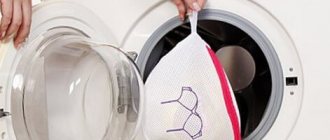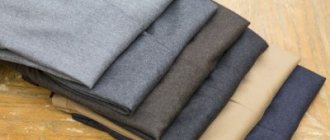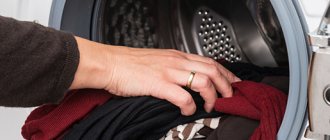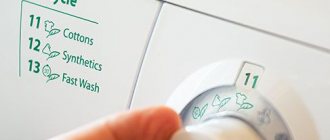Updated: 05/29/2021 14:56:27
Expert: Panteleeva Irina Vladimirovna
Socks are a hot topic for modern fashionistas. Some specimens are like works of art. Therefore, the question increasingly arises of how to properly care for an important part of your wardrobe. Mothers of babies are puzzled by this issue, since children's socks get dirty quickly, like all the clothes of little explorers. And, even for those people who choose conservatism, the issue of caring for socks arises every day.
If you want to keep your socks looking good for as long as possible, follow our tips.
How often should you wash your socks?
The usual procedure for changing socks boils down to the following rule: change daily, wash as accumulated or necessary.
It is not at all necessary to start the washing machine because of one pair. Also, you should not wash your socks separately from other clothes. The main thing is to sort by color and type of fabric.
In case of emergency, you can quickly wash your socks by hand.
The rule changes if you put a stain on the knitwear. In this case, there is no need to put off washing for a long time. Remember: the fresher the stain, the easier it is to remove.
To save time and choose the right solution, we offer a small checklist:
- You need to change your socks daily. A light degree of contamination will avoid rough washing, which leads to deformation of the knitwear and the formation of pills.
- You should wash as needed or when you have accumulated enough socks that you feel comfortable turning on the washing machine.
- When storing in a laundry basket, it is advisable to put one sock inside the other. In this case, you will save yourself the trouble of searching for a match. If possible, collect dirty socks in a separate container.
- We recommend that heavy dirt and stains be washed immediately. Old dirt penetrates deeply into the fibers and is much more difficult to wash off. There is a need to use stain removers and bleaches.
Rules for washing knitwear
The general rules for washing textiles also apply to washing socks. Here are the most rational requirements:
- Separate knitwear by color. Some specimens may shed heavily.
- Before washing, be sure to turn your socks inside out to remove any accumulated dust.
- To prevent socks from getting lost among your clothes, place them in a special laundry net or use a pillowcase with a zipper for this purpose.
- Choose the right temperature. Cotton products can withstand heating up to 100 degrees. You can even boil them. For synthetics, a mode with a temperature of no higher than 60 degrees is suitable. It is better to wash wool items by hand in slightly warm water.
- For detergents, choose regular washing powders, enzyme detergents, soaps, and fabric softeners.
Getting rid of odor
An unpleasant odor is a consequence of excessive sweating or prolonged wear. To eliminate it, you need to change the water several times during washing. To enhance the cleaning effect, you can use freshly squeezed lemon juice or orange peel. With the right approach, the odor neutralization process will not take much time.
Particular attention should be paid to detergents. Their composition is the determining factor. By following the recommendations on how to wash socks in a washing machine or by hand, you can extend the life of the products.
Rate this post
Machine washable
For those who are encountering this issue for the first time, we will break down the process of washing socks with a machine.
Necessary equipment
Before you start washing, make sure you have the necessary supplies and equipment. We will need:
- Washing machine.
- Zip mesh bag (optional).
- Powder or liquid laundry detergent.
- Laundry soap, bleach, stain remover.
- Fabric softener (conditioner).
Preparing for washing
Before sending the hosiery fabric into the machine drum, you need to perform the following preparatory procedures:
- Separate your socks by color. Dark, light and colored items should be washed separately. If all your socks are different colors, choose items that are similar in shade or do a dye fastness test. To do this, wet the product and apply a light napkin to it. Fading fabrics will immediately reveal themselves by dyeing the napkin in the appropriate color.
- If the sole is already fairly trampled, the white items have become gray, and the black ones have acquired a gloss, you need to wash your socks first. To do this, turn the knitwear inside out, wet it, rub it with laundry soap and leave it to sit for 15-30 minutes. Then rub the items a little, rinse and put them in the machine.
- In case of heavy soiling, before washing the machine, use the bleaching and stain removal methods that we will suggest later in the article.
Mode selection and washing
Now we send the prepared socks into a big wash. To do this, follow our instructions:
- Place items of the same color into the drum and close it.
- Select a wash program. Wash sufficiently soiled items in the normal cycle, which includes a full wash cycle, rinsing and spinning. If you only need to freshen your laundry, you should use the quick wash mode. If necessary, use the appropriate buttons to adjust the water temperature and spin power.
- Pour the required amount of product into the powder compartment up to the mark. If you use the fast mode, you can reduce the dose of powder by half. Place the liquid capsule product in the drum.
- Click the start button.
- After the drum stops and the machine door is unlocked, immediately remove the laundry. Leaving wet textiles in a closed space for a long time can cause an unpleasant odor.
- Hang things out to dry. Avoid drying white socks on metal radiators. This can lead to rust stains that are very difficult to remove.
- Store your socks in a dry place, folded one inside the other.
These recommendations apply to the care of any type of socks: adults and children. The only exception for washing children's clothes is the use of hypoallergenic detergents.
About thermal socks
There is no better product for athletes, tourists, lovers of an active life, and simply for everyday wear, especially in cold weather, than thermal socks. They reduce friction when walking, remove moisture from the skin, and maintain comfortable warmth and dryness. And, again, it is incorrect washing that will deprive these wonderful socks of their wonderful properties, turning them into ordinary hosiery. To prevent this from happening to your property, follow the recommendations from the table on how to wash thermal socks:
Socks that are not very dirty can be washed anyway
| Type of wash | Without losing their properties, thermal socks can be washed both by hand and in a washing machine, selecting the delicate cycle. |
| Water temperature | For hand washing, the normal temperature is 40 degrees, for machine washing - 30-35 degrees. |
| Detergents | Avoid powders containing chlorine and other harsh bleaches and stain removers. For hand washing, regular soap is suitable. Of course, dry cleaning is contraindicated for thermal socks. |
| Spin | When hand washing such socks, you need to shake them vigorously several times and then squeeze them between your palms, never twisting them. In a washing machine, it is better to use the no-spin mode, or set it to the minimum values - no more than 200 revolutions. |
| Drying | Thermal socks are dried at normal room temperature. Be careful - drying on a radiator, in a dryer, as well as machine drying will inevitably lead to the loss of all thermal properties. |
| Ironing | Ironing thermal socks is prohibited for the same reason. |
If you follow all the recommendations, thermal socks will serve you for a long time
Improper washing will ruin the structure of the material.
The best is hand washing. Do not turn on the spin cycle in the washing machine.
Read the label carefully
In order not to deprive thermal socks of their properties, you need to wash them correctly
Handwash
This type of washing is considered delicate and has a whole set of advantages:
- A useful skill that will come in handy if it is not possible to wash things in a machine: while traveling or in case of a power outage.
- Using manual labor saves water and energy consumption.
- Significantly less chance of damage to products, their deformation and shedding.
At the same time, hand washing requires free time and physical effort.
Peculiarities
The procedure for washing socks by hand is different. that all actions are performed manually: from washing to spinning.
Sequencing:
- Sort things by color.
- For heavy soiling, pre-wash, remove stains or bleach.
- Fill a basin or other container with about 10 cm of water.
- The water temperature should not be high and comfortable for your hands. When washing wool socks, use water at room temperature.
- Protect the sensitive skin of your hands with rubber gloves.
- Dissolve the required amount of powder well in water. Usually 3 liters. 0.5 tbsp required powder.
- Place the socks in a container and leave them to soak for 5 minutes. At this time, you can stir things by making circular movements with your palm.
- After this, do a general wash: take the items with your hands and rub them against each other. Most of the dust and light dirt will be removed at this stage.
- Now move on to individual washing. Take each sock and rub it between your toes, moving along its entire length. Dip the jersey into water and scrub again.
- Wring out clean items and place them separately for further rinsing. You can immediately place a basin of clean water next to it.
- Rinse the washed socks thoroughly, removing any remaining detergent. To do this, you can use running tap water or alternate rinsing in a container of clean water. If desired, add fabric softener to the final rinse.
- Wring out the knitwear thoroughly and hang it to dry. The best option is to dry in the fresh air or in a draft.
Tricks for making products shrink
It often happens that products stretch and become deformed. There are a few tricks to help your socks return to their previous shape. The easiest way is to use hot water (20-30 degrees higher than specified by the manufacturer), but only if the sock material can withstand heat treatment. If possible, boil followed by rinsing and spinning.
Another method actively used by housewives:
- After washing, soak the items in hot water (up to 70 degrees).
- After a quarter of an hour, gently squeeze.
- Place socks in ice-cold liquid.
- Leave for half an hour.
- Wring out and dry on a clean terry cloth.
A hot battery will perfectly remove deformation and stretching. The method is usually used for woolen products. Soak the socks in hot water, wring them out lightly, and hang them on hot radiators. Wait until completely dry.
Pre-treatment agents for heavy soiling
As promised, we present additional products that will help get rid of severe dirt and stains. The proposed products are prepared independently from available components. You can also use special household chemicals.
Homemade formula for dirty white and colored socks
This method includes the most common components and is suitable for treating heavily soiled items. Removes old stains and dirt. This product should not be used on wool socks.
To work you will need:
- water (cold and hot);
- laundry soap;
- washing powder;
- table salt;
- baking soda;
- ammonia solution (ammonia);
- metal pan;
Sequencing:
- Wet your socks and wash them with laundry soap.
- Rub the knitwear with the same soap, leave for 30-60 minutes, then rinse.
- Place 2 tbsp in a metal pan. l. washing powder, 2 tbsp. l. salt, 2 tbsp. l. soda, 1 tbsp. l. ammonia. Pour the mixture with 2 liters of hot water (brought almost to a boil).
- Place socks in the solution, bring the liquid to a boil and boil for 5 minutes.
- Leave the container to cool. You can leave things in the solution overnight.
- Remove the laundry and rinse in clean water.
Whitening product for light-colored socks
This method will return snow-white freshness to even worn-out socks. The components are found in every home or are available for purchase at your local store.
To prepare bleach you will need:
- plastic basin;
- 3 liters of warm water;
- 1 tbsp. l. hydrogen peroxide;
- 2 tbsp. l. aqueous solution of ammonia (ammonia).
Before soaking in the solution, you must wash your socks by hand with laundry soap. If the socks are heavily soiled, leave the soaped socks on for 10-15 minutes and then wash them again.
Whitening process:
- Pour water into a plastic bowl and add the required amount of hydrogen peroxide and ammonia to it. Mix the ingredients thoroughly.
- Place the socks in the solution and leave for a while. The bleaching period depends on the degree of contamination of the items. Sometimes it can take up to 2 hours.
- After bleaching, wash the items again with laundry soap or washing powder.
- Rinse the knitwear well.
Laundry soap for white and colored socks
We will use simple laundry soap. This old, proven remedy helps out in different situations. It will also help in washing socks.
The method of use is extremely simple:
- Wet your socks and wash them with soap.
- Lather things thoroughly with laundry soap. Place them in a plastic bag and leave for 12 hours (overnight is possible).
- Remove the treated knitwear, rub it well and rinse under running water.
Household chemicals
The special composition of bleaching and stain removing agents is designed to be gentle on fabric fibers and dyes. However, with frequent use of chemicals, the fabric becomes thinner and things become unusable. After 5-7 washes with chlorine bleach, the socks can be thrown away. In addition, not all things are made from natural white fibers. Often the fabric is simply dyed white. And with intense exposure to detergents, the paint is washed off and things turn gray or yellow.
To restore the cleanliness and whiteness of your favorite socks, you can buy any of the following products:
- Bos maximum.
Suitable for colored and white fabrics. Operating temperature range from 30 to 50 degrees Celsius.
- Sarma Active
. Powdered bleach. Can be used for hand and machine wash. Not effective at low water temperatures. To remove difficult stains, several treatments are required. Cannot be used on silk and wool.
- Vanish oxidation
. Fast-acting liquid product. Effectively removes even the most stubborn stains. It begins to act already at low water temperatures. You can soak clothes in the prepared solution, or you can apply it pointwise to areas of contamination. Suitable for delicate fabrics.
- Persol
. This domestic powder product for white and colored laundry copes well with various stains, removes yellowness and gray stains. It is most effective at a water temperature of 50 degrees Celsius.
- Chirton.
Works in both hot and cold water. Removes stubborn stains from colored and light-colored items.
- Eared nanny.
Suitable for washing children's clothing as it contains non-toxic components.
- Umka
. Another safe bleach for children's clothes. Consists of a soap solution with active oxygen.
The products listed are an excellent alternative to chlorine-containing bleaches. Before using them, you must read the instructions for use. Proper concentration and time will allow you to get optimal results.
Processing features depending on color: white, dark, colored
Dirt is more noticeable on white socks than on dark ones. Therefore, you have to wash them more often.
To remove blackness and prevent yellowing of the fabric, you can periodically use bleaching compounds. These can be chlorine-containing products, but you need to take into account that they lead to tissue damage.
The fibers lose strength and holes will appear on the product faster. Therefore, preference should be given to delicate bleaches containing enzymes and active oxygen.
Examples of such means are:
- Vanish Oxi Action Gold (the cost of 0.45 ml gel is about 145 rubles),
- Boss Maximum (for 0.45 powder you will have to pay about 50 rubles).
Colored socks are washed separately from other items, as they tend to fade and stain light-colored fabrics.
To care for them, stain removers that do not contain a bleaching component are used . The optimal washing temperature is 40 degrees.
Black socks are considered the easiest to care for. The stains on them are not so noticeable, so they are washed less often than white items.
However, they can only be processed with plain items . Even firmly dyed fabric causes white items to turn grey.
Read about the rules for washing white socks by hand here.
Washing children's socks
A special feature of caring for children's things is the use of special products that do not cause irritation to sensitive children's skin. The washing process itself is no different from normal. Manual and automated processing can be used. The main aspects are keeping things soft and clean.
Socks are an important attribute for a person of any age and status. By following our simple instructions, you can easily keep your linen fresh, please your loved ones and gain confidence in the impeccability of your appearance.











